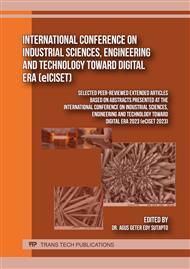p.3
p.9
p.15
p.23
p.31
p.43
p.49
p.59
p.65
Development of the Obstacle Avoider of Fish Robot
Abstract:
The extraordinary swimming capacity of fish in nature makes them unique among Allah's creations. It is extremely difficult for a robotic system to achieve fish-like swimming behaviors, especially in terms of swimming performance. Many fish use their pectoral fins to provide thrust over a wide speed range and to carry out tricky maneuvers. In this paper, we report a robotic fish that can travel forward and backward using its propulsion system. In this report, the creation of a conceptual design for an interactive fish robot took into account a number of factors, including swimming ability, leakage testing, and motion controller. This needed considerable mechanical design work, and the result is a quick-return mechanism for the fish's body. We made the decision to divide the body into the head, body, and tail. In order to create the propulsion system, we employed five servo motors. Finally, controlling the robot's motion is absolutely essential, especially if there is an obstruction in its path. The servo controller, which is located at the fish's head, serves as the primary controller for all of the motors and sensors.
Info:
Periodical:
Pages:
31-40
Citation:
Online since:
March 2024
Price:
Сopyright:
© 2024 Trans Tech Publications Ltd. All Rights Reserved
Share:
Citation:



